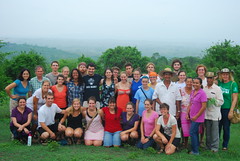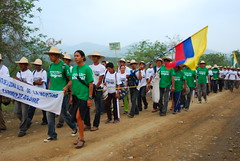 I visited Medellin, Colombia for our week of service learning during the semester. On Thursday, April 11, Emma Dalen, EMU graduate Jessica Sarriot, and I took the Medellin metro to Interamericana Filadelfio church which hosts a program called Fundacion Raices de Fe, or, Foundation Roots of Faith, for students ages 8-17. It is a before and after school program because the schools have half day schedules and the kids need something to do the other half of the day. I’m an art and digital media major, so the program asked me to plan and lead some art lessons for the students. I’ve never taught an art lesson or led a bunch of kids before, so I was pretty nervous about how challenging it might be, especially with my limited Spanish. The morning group was about 30 students and arrived around 9:00.
I visited Medellin, Colombia for our week of service learning during the semester. On Thursday, April 11, Emma Dalen, EMU graduate Jessica Sarriot, and I took the Medellin metro to Interamericana Filadelfio church which hosts a program called Fundacion Raices de Fe, or, Foundation Roots of Faith, for students ages 8-17. It is a before and after school program because the schools have half day schedules and the kids need something to do the other half of the day. I’m an art and digital media major, so the program asked me to plan and lead some art lessons for the students. I’ve never taught an art lesson or led a bunch of kids before, so I was pretty nervous about how challenging it might be, especially with my limited Spanish. The morning group was about 30 students and arrived around 9:00.
We began with painting. Each student had a small piece of a photo to copy on a bigger paper. When everyone finished we put the parts together to make the bigger picture. It ended up being a little abstract, but the kids had lots of fun. Then we made origami paper cranes. Here I could really tell that these kids wanted attention and affirmation, more than any other kids I have met. They paid really close attention to each step I demonstrated, and when they got it right, they ran up to me and showed me what they did and waited until I told them it looked good. With 30 students, this was a bit hectic. Emma and Jessica were great helpers, showing the children what I was demonstrating up front. Around 11:30, the first group left to go to school and Emma, Jessica, and I got a break to eat lunch, play Rummy-Q with the pastor of the church and prepare for the 32 students that came around 2:00.
With this group, we did the photo enlargement activity again but with pencils to teach them about shading. Then we made cranes and painted as table groups the things that were most important to them. Again, without the support of Jessica and Emma, things would have gone badly. This group was much rowdier and messier, but they also showed incredible creativity. I was very impressed by some of the creative and clever things the kids in both groups came up with. I hope they learned something about art or at least became a little more comfortable with displaying their artistic side.
This experience for me was stressful and out of my comfort zone, but it was an important learning experience and an opportunity for me to give back a small amount of what the people in Guatemala and Colombia have given to me on this trip.
– Karla Hovde
April 6
Today I woke up at 4:45 a.m. to the sounds of engines, shouting,  and roosters. It was day one of La Caminata, a march of 700 farmers from the Montes de Maria, who plan to march for a week to Cartagena, 180 kilometers from here. By the time I was ready, all 700 people were packed, dressed in their marching green shirts and straw hats, standing at the start ready to walk. The mounds of food they had all brought from their communities was loaded in the trucks, hammocks cleared from trees, and so at dawn we began.
and roosters. It was day one of La Caminata, a march of 700 farmers from the Montes de Maria, who plan to march for a week to Cartagena, 180 kilometers from here. By the time I was ready, all 700 people were packed, dressed in their marching green shirts and straw hats, standing at the start ready to walk. The mounds of food they had all brought from their communities was loaded in the trucks, hammocks cleared from trees, and so at dawn we began.
We cheered as we marched. “La montana?” “Presente!” People would come out of their houses when we walked through neighborhoods, clapping at the cheers, giving leaders money to support the cause, or just smiling and watching us go past. They knew well why we marched for 6 hours in the hot Colombian sun to San Jacinto that day: so that these families and many more can finally receive government assistance after years of unused medical clinics and vacant schools with unpaid teachers, and so that communities could finally feel the support of a government that cares for their crops, their roads, their futures. And so, with determination under each step, and accordion music in our ears, we marched, and will march, until justice has been felt by Monte Maria.
– Lani Prunés
April 2
Today we had two interesting visits, but the speaker at the first one, Cesar Garcia, said something that was very interesting for me, and in many ways serves to reaffirm my belief in pacifism. Cesar said that the armed revolutionary movements created the conditions that led to the paramilitaries, and together, the two groups created an armed struggle which served to move more people off their land and further aggravated the gap between rich and poor. Ironically, the armed revolutionary movements were created specifically to combat this gap. It seems to me that this is a recurring theme on this trip. Violence does not address the problems that it was formed to address; instead, it often aggravates them. I’m left wondering what would have happened if the money and energy used on the armed movement had been used for a peace movement instead. Might Colombia be more peaceful today?
– David Yoder
April 13
Last day in Medellin, Colombia
Today was a great ending of our time with Jess Sarriot http://emu.edu/now/news/2012/09/fresh-grads-serve-in-war-torn-areas-of-colombia/. We just hung out around the house and packed and ate, talking and laughing the whole time. Then we went to a nail studio 1) to talk to the woman who ran the salon because she was displaced and 2) so Karla could get her nails done. Jebeisa was a beautiful black woman originally from Choco. She was very welcoming of our questions and she felt it was important to tell her story. It took much longer than the usual 45 minute nail treatment for us to hear it all.
On May 3, 2009 Jebeisa and her husband were sitting in their living room around 7:00 in the evening when a man broke in the door and shot her husband in the head and her through the left forearm, breast and right thigh. She doesn’t remember who was shot first but that her son was safe in his room. She came to from a coma 29 days later, in Medellin. After about three months of recovery her son joined her in Medellin where they have been living ever since. She had a hard time getting things together with the insurance and government aid at first but with the help of her mom and dad it all came together and she owns the studio, her home, and is remarried as of 8 months ago. When we asked her who did it, she said nobody in the world could tell. It’s a common thing and it’s even harder to tell the reasons. I was amazed by how calm she was, she laughed a surprising amount and never once cried. She was an amazingly strong lady. Karla and I talked later about the numbness and vitality due to fragility complex that such violent societies assume. The U.S. is numbed to violence because of the media and entertainment, whereas Colombia is numbed due to the daily reality, but that same reality also makes life more precious too, in some cases.
After our time with Jebeisa we literally ran back to the house to grab our stuff and take a taxi to the bus station where we had lunch with Oscar, and got the opportunity to write down a timeline for him. We had a good goodbye with him before he had to leave, then just sat in the café with Jess and talked with her about sustainability and life in general. I really hope that this relationship can continue. We all had a really good time. The best part of the trip was getting to know Jess and learning through her about so many cool things. I also loved that it was such a small group that allowed for more intimate contact within and in relation to other groups, organizations and individuals. This was definitely in the top three best parts of cross cultural.
– Emma Dalen